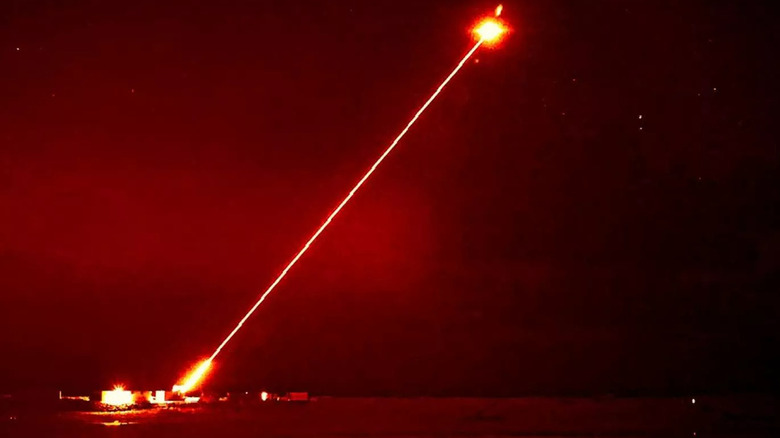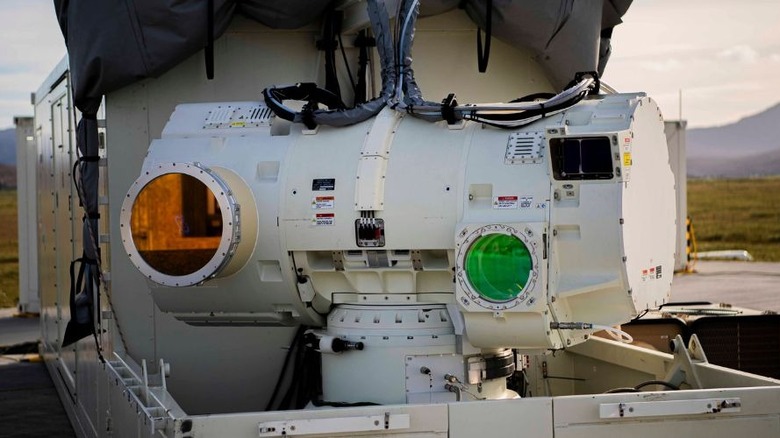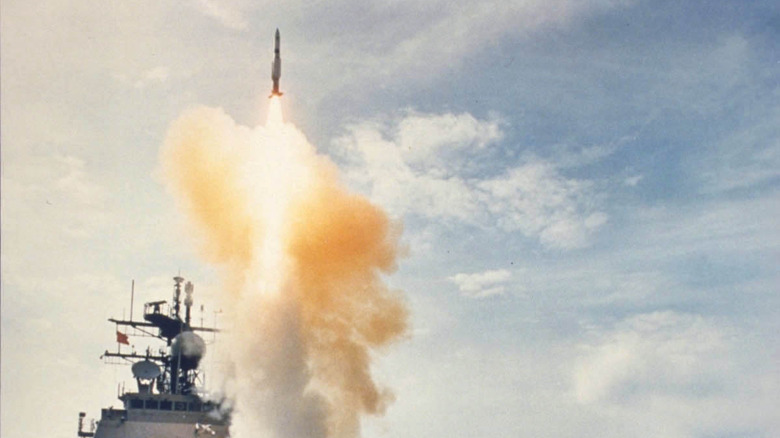The British Navy Will Use Lasers To Zap Drones Out Of The Sky: Here's How
While laser-based warfare may seem like something you'll find in a game like "Starfield," the reality is it's already here. Or at least it soon will be. The Royal Navy is just a few years away from fitting its ships with DragonFire — a laser-based weapon designed to counter drones and other aerial threats. Some videos also showed the laser taking out smaller vessels, though its main focus is definitely skywards.
The seemingly space-age weapon is set to appear on Royal Navy vessels from 2027 — five years ahead of its originally planned debut. The British Ministry of Defence has apparently shifted the date forwards due to current global affairs. We may also see DragonFire in action before then, as the U.K. Defence Secretary told reporters: "Let's say that it didn't have to be 100% perfect in order for Ukrainians perhaps to get their hands on it," (via BBC).
Many other laser-based weapons are currently in development, including one that the U.S. Navy tested back in 2020. There is a lot of overlap with the tech, and most systems have a similar focus. Here's everything we know about DragonFire, the laser-based tech that Britain's Royal Navy will soon be adding to its arsenal.
The system relies on a 50KW laser
The laser itself is in the 50KW category, which is pretty destructive to most things that get in the way of it. Being a light-based weapon, its beam travels at the speed of light — which at the range it will be used means targets get hit just about instantly. That initial "hit" won't necessarily instantly destroy a target, but the weapon is capable of keeping that beam focused on a quick moving object for an extended period, and sufficient damage may occur within a few seconds.
The laser is also extremely precise, and can hit targets smaller than a quarter from a kilometer (0.62 miles) away. This precision is necessary because, despite its output, the laser will still need a short amount of time on the target to melt through any casings and components. In tests, it's managed to melt through everything from drones and sheet steel to the side of a 120 mm mortar shell. While we know its accuracy at a kilometer, its full range is classified.
It's cheaper and more practical than conventional countermeasures
Traditionally, airborne targets like drones, missiles, and enemy planes were countered with missiles. However, missiles come with their own sets of problems. Firstly, they're expensive. Missiles used to take down things like drones can cost millions of dollars apiece. The Standard Missile-2 surface-to-air missiles that the United States has been using to fend off Houthi drone attacks cost around $2 million each, while Standard SM6 missiles can cost double that. A blast from the DragonFire laser is estimated to cost around $12. Sometimes the missile costs significantly more than the drone it is targeting, which can balance things out a touch in asymmetrical warfare. That's no longer the case when a ten-second burst from a defensive weapon uses the same amount of energy as a standard heater does in an hour.
Then there is practicality. Missiles take up a lot of space, add a lot of weight, and each ship can only hold so many. This can severely limit the length of operations, especially if an enemy is constantly bombarding a fleet with "swarm attacks" which involve large numbers of cheaper drones and rockets. While the unit firing the laser isn't exactly light, it is a lot lighter than a full store of missiles. That extra space can then be used for other supplies, or the anti-air missiles can make way for other types of specialist ballistics — like anti-ship missiles or munitions designed to take out land-based targets.
A ship is the ideal place for a laser weapon
While land-based laser weapons have surfaced in recent history, a ship may be an ideal place for them as things stand. They tend to be pretty heavy and require a lot of power. If that power is being stored in batteries, weight goes up and the finite capacity means the laser can only be used so many times before going back to base for a lengthy recharge. However, none of this matters on a ship. Weight when compared to the ship itself is negligible, especially compared to what the system is replacing. On the energy front, as ships are capable of generating their own power, the laser weapon can be used as many times as necessary. Ships also have other systems which can play very nicely with the new tech. Radar, for instance, can be used to spot targets which the laser can then zone in on.
There are also a few drawbacks. A laser is a beam of light, and light tends to only travel in a straight line in most circumstances. This means the laser can only hit things that the DragonFire unit has a clear view of, unlike missiles which can work their way over obstacles. Cloud cover, a particularly smoky conflict zone, and many other things hanging in the air could scatter the light beam and lower the laser's effectiveness. There's also a chance it could overheat during extended use.


